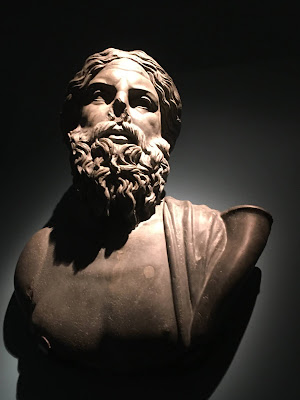"More than 1,200 years ago, the cities of Thonis-Heracleion and Canopus on Egypt's north coast disappeared beneath rising waters and natural disasters. Although ancient accounts told of their splendor, these cities were largely forgotten, lost in the Mediterranean sea.
In 1996, marine archaeologists began searching Aboukir Bay for traces of the lost cities. The team rediscovered the two cities, uncovering important artifacts and deepening understanding of life in ancient Egypt at a time of intense contact between Egyptians, Greeks, and Romans. These cities were also important religious centers and linked by an annual religious ceremony, the Mysteries of Osiris."
The Late Period (664 - 332 BC) saw increasing trade between Egypt and other parts of the Mediterranean, mostly via the port of Thonis - Heracleion. Through this port, goods and people poured into the Nile valley, and interactions between the Egyptian and Greek world grew.
The Ptolemaic Period (323 - 30 BC) witnessed the development of a mixed Egyptian-Greek culture under the Ptolemies, a dynasty of Macedonian Greeks. The capital, Alexandria, grew to be the largest city of its time and came to replace Thonis-Heracleion as an international port.
The Roman Period (20 BC - AD 391) began with the suicide of Egypt's last Ptolemaic ruler, the renowned Cleopatra VII, in 30 BC. During the Roman Period, Egyptian cults spread throughout the empire. Even after Theodosius I banned pagan cults in 391, Egypt remained a part of the Christianized Roman Empire until the Islamic conquest in AD 641.
Statue of Arsinoe II, c. 300 - 200 BC
Carved from a dark, hard stone, this sculpture is a magnificent example of Greco-Egyptian art. The striding pose is rather traditional and formal in Egyptian art; in contrast, the Greek-style drapery both reveals and accentuates the idealized body of the queen. Gone is the traditional Egyptian back pillar, replaced by the folds and pleats of the clinging garment that give dynamism to the queens's rigid posture.
Statue of Horus Protecting Pharaoh c. 350 BC
The Egyptians believed that every pharaoh was the earthly incarnation of the god Horus, son of Isis and Osiris. In this remarkable statue, Horus as a falcon stands guard over an unidentified pharaoh between its talons. The king, with his feet together and palms against his thighs, is in a position of prayer. This composition reinforces the association of the pharaoh as simultaneously Horus and a human ruler on earth.
Bust of Neilos, God of the Nile, c. AD 100 - 200
Neilos, the god of the Nile in Greek and Roman culture, is shown here in a classical Greek style with a thick beard and hair held back from his face in a bun. He carries a cornucopia that symbolizes the Nile's abundance.
Discovered in the submerged city of Canopus, this Roman sculpture shows how traditional Egyptian religious beliefs changed in the Greek and Roman periods. For thousands of years, Egyptians honored, celebrated, and worshipped the Nile River as the giver of life. Without the river's annual flood to fertilize Egypt's fields, life in the region would collapse.
Head of a Priest, c. 332 - 30 BC
Priests are recognizable in Egyptian portraits by their complete lack of hair, as in this example. As temple officials, priests were fully shaved to ensure their ritual purity before the gods. When the Ptolemies ruled Egypt, they respected Egyptian religious practices and, in turn, were frequently supported by the Egyptian priesthood. Not only did Greeks and Egyptians honor each others gods, but some Greeks even became priests of Egyptian cults.
This head was found during excavations of the eastern harbor of Alexandria, and its worn facial features are likely the result of the many years it spent under water.
Religion in Ancient Egypt:
Ancient Egyptians were polytheists, people who believed in many gods. Their complex religion saw parallels between divine and mortal worlds as well as the world of the dead.
This exhibition is especially concerned with Osiris, who was the mythical first king. He was slain by his brother Seth and resurrected by his sister-wife Isis; and from their union came Horus, Osiris's heir and avenger. Together, Osiris, Isis, and Horus formed the Osirian Triad. Upon his death, Osiris ruled in the netherworld while Horus ruled among the gods. Ancient Egyptians identified the living pharaoh with Horus and the pharaoh's wife with Isis. Osiris was identified with the deceased pharaoh. Thus, the ruling family was the manifestation of the Osirian Triad on earth.





No comments:
Post a Comment